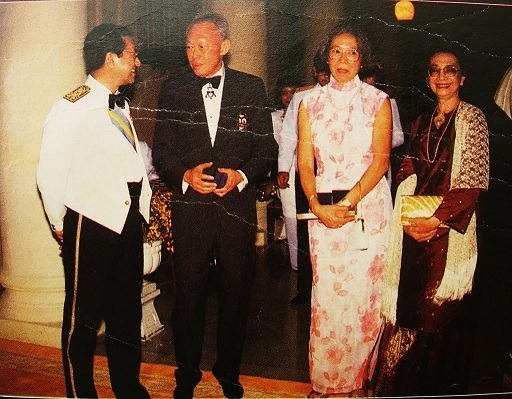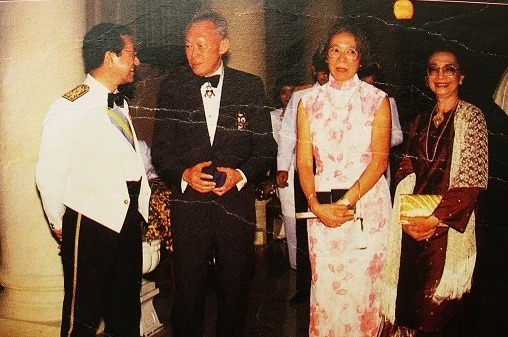In our Selected Exhortations category, we republish interesting stuff such as must-read articles and essays not originally written exclusively for the blawg, and which have come to our attention. Please feel free to email [email protected] if you would like to reproduce your writing, but first follow our Writer’s Guide here.
This article by Bridget Welsh was originally published at New Mandala.

In the last few years, both Malaysia and Singapore have been undergoing political liberalisation, evident from the increasing parliamentary representation of the opposition and more open political discussion. Yet, with this opening, the challenges the two neighbours face in liberalising are becoming clearer. One of the main obstacles involves dealing with the legacies of Lee Kuan Yew and Dr. Mahathir Mohamad, as their imprint on politics continues to overshadow current transformations. How do the legacies of the two strongmen constrain contemporary political change?
Lee Kuan Yew and Mahathir Mohamad were successful leaders, delivering economic progress and giving their countries international prominence. However, views of these leaders remain divided, with some lauding them as political strongmen who delivered development and stability and others highlighting their excesses. This debate will continue, and likely intensify over time. Still, few dispute the fact that the two leaders profoundly shaped the countries they led. In order to understand contemporary politics in both countries, we need to look beyond these leaders as individuals or their tenures and appreciate how the strongmen continue to shape the two societies.
The Strongmen Psyche
Lee Kuan Yew governed for 31 years, Mahathir 22. Both former leaders continue to play roles in politics, despite stepping down from office. Given their prominence, it is understandable that elements of their style of leadership have become deeply ingrained into the public consciousness. The most evident of these is fear. Fear is defined as an emotion induced by perceived threats and is part-and-parcel of the political landscape of strongman rule. It is not just about the fear caused by the use of the state apparatus through draconian laws for arbitrary arrest or the penalties for breaching the boundaries of what is deemed as unspeakable, it is also the routinisation of warnings and demonisation of the other.
For decades Malaysians and Singaporeans were encouraged to conform to set patterns of political behavior – to not question their leaders and follow. They were expected to fall in line, as the system was deemed the best for them. They were warned repeatedly to behave. Red lines – ubiquitously known as OB (out-of-bounds) markers in Singapore – were clearly drawn – not to criticise leaders, not to discuss ‘sensitive’ issues, or not to express alternative views openly. The end result was possible penalties, which ranged from outright arrest to quiet marginalisation. The actual number of arrests was low relative to other regimes, but such instances took on symbolic importance, especially given the relatively low populations of both countries. While fear has sharply dissipated in the post-strongman eras, it still permeates political life, especially among the generations that lived though these periods.
Fear of the state was is just part of the story. During the strongman era, fear was used to buttress power. Threats from outside were a constant refrain. In Malaysia, these threats came from enemies in the form of George Soros, Jews or unknown forces of instability that could not be controlled. The threats also came from within. Mahathir was perhaps the most explicit on this in his book Malay Dilemma, which used sharp ethnic divisions as a source of internal instability. The push for Malay unity was used to fend off the other. In Singapore, the ethnic rubric was one of multiculturalism, but memories of the turbulent ethnic tensions of the 1950s and 1960s remained. Events such as 1969 in Malaysia or 1964 in Singapore continued as part of the political discourse, and still do today. There is unease, anxiety and concern about a return to the ethnic turbulence of the past that meshes with the subtle and sometimes not so subtle dimensions of fear.
Political liberalisation in both countries is constrained by fear and the baggage it brings. A key element of this baggage is mistrust. On an interpersonal level, race relations in both countries are strong – and this is despite a number of high profile and controversial racial comments that have recently received public attention, notably in Singapore. Yet, deep-down the niggling uncertainties of the ‘other’ so prominent in the strongman era remain.
Strongman Control Mode
This strongman legacy is not just about fear – it is also about control. The focus on a specific order was a feature of the strongman eras. The structure of this order varied in both societies, but the pattern of establishing the order was the same – it was to be defined by those in power. Space for alternative conceptualisations was minimised, as leaders set out the course for the country to follow. In many of these decisions, there was wisdom, while in others, less so. But the mode of engagement was the same – the ‘government – a.k.a. leader – knows best’.
The strongman eras in Singapore and Malaysia’s placed the state in a dominant position as the driver of society. In the economic realm, the state was to be the agent of change, usually in alliance with international business. This has meant that the space for domestic private business interests, especially small and medium-sized businesses, as an alternative engine of growth has been minimised. For multiple decades, public spending, allocations and priorities were set by those in power. This provided a powerful economic base for the control of society.
Dominance over the economic levers of power reinforced the strongmen’s position politically. To challenge political power under strongman rule had the potential to undermine your economic fortunes. This dynamic is deeply rooted, as challenges to the status quo are seen to both backfire on those who engage in them and come at a high price. The legacy of this pattern continues, as those who speak out face marginalisation, and in some cases, outright demonisation. The attacks are particularly harsh on those who come from within the system and are seen to betray the incumbent’s political base. The response to Anwar Ibrahim is illustrative.
Politically, the strongman mode of control was also characterised by a ‘divide and rule’ strategy of engaging opponents. As a result, civil societies in both countries are fragmented, wracked by internal suspicion. Those that were co-opted are distrusted by others who are seen as more confrontational. The strategy of division reinforced the position of the strongman leader, a feudal structure of personalised power around one man. Even today, centralised leadership is expected, with heavy burdens placed on the post-strongman leaders to perform and to ‘be strong’. Today’s leaders are constantly compared to the past. Power continues to be personalised, although in Singapore this is less about personality than persona.
Strongmen Institutional Constraints
This element of persona – how people interpret the leadership of the past – still resonates today. Many in both countries refer to the ‘good old days’ when government was omnipotent and the rules of the game simpler. Many in government have trouble dealing with criticism, often viewing discussion of issues as attacks and responding defensively. The irony is that the post-strongman era has led to needless insecure responses by leaders that are hampered by comparisons to the strongmen and the constituencies that claim to act to protect the strongman legacies. The burden of being in the shadow of strongmen is heavy – as it is increasingly laden with discomfort and anxiety as governance has become more decentralised and a broader spectrum of the population has ratcheted up demands on the government and criticism of its performance.
These changes have placed greater burden on the different institutions to govern. The post-strongmen eras have seen the institutions and the bureaucracy move to the frontline. Here is where the trajectories of Malaysia and Singapore diverge. Mahathir’s legacy was to weaken institutions on multiple fronts. This story is well-known – the corruption, the diminished capacities and the inefficiencies. There are talented Malaysian civil servants, but the modus operandi reinforces bad practices and those that rise usually do due to their loyalty rather than merit. The rot inside the system has led to the increasing displacement of the civil service in governing, illustrated by the rising power of consultant agencies in policy formulation. Whether it is the police, judiciary or civil service, it is a constant battle to deliver. This is the Mahathir legacy of disempowerment of government agencies, of neutering initiative and discouraging problem-solving. It is also the result of reinforcing the predatory practice of power for oneself, rather than for the people.
Singapore’s institutions did not suffer the same fate. The public sector plays a prominent and respected role in governing and takes this role seriously. The legacy is exactly the opposite – too much strength tied to insulation. The voices of civil society are missing or even dismissed. There is selective hearing on who to engage and how. Within the system there is over-bureaucratisation of the bottom, and limited checks at the top, as the fundamental operating principle has been to check those below and empower the elite. This limits the quality of the feedback for the system to evolve and address the new challenges ahead, particularly given that many in Singapore’s civil service now comprise the elite in a process of early self-selection and recruitment. As in Malaysia, institutions in Singapore continue to be shaped by the past.
Path Ahead
As these societies change – and they have done so rapidly – the institutional norms and effects of the strongman eras persist. Today, there is much less fear and less control, although many in the system are nostalgic for the period where citizens were subjects and followers rather than participants and questioners. The process of political liberalisation involves tackling the unspoken legacy effects of past leadership – to move from fear to trust, from intolerance to acceptance, from insecurity to security and from constraints on governance to empowerment.
The region shows us that there are two paths – one of big bang change with reforms and another of muddling through. We have seen examples from Indonesia to Myanmar. The reality is that no matter what path is followed, the legacies of strongmen persist. There is always a cohort that holds to the past and the routines that have been institutionalised and normalised are difficult to change. This is why it is so important to understand how the past is shaping the present. This recognition of legacies involve both the government protagonists and citizens – as it is only when both appreciate the relationship between the past and the present that these societies can move toward a more holistic embrace of their potential.
Bridget Welsh is Associate Professor in political science at the Singapore Management University. This article is based partly on her lecture at the Asia Pacific Learning Community Forum, “Malaysia and Singapore – Models for the Asian Century.” The video of her lecture and the forum is available here.


Nice!